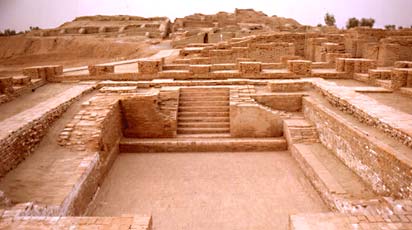The rise of the post-Neolithic Bronze Age Harappan civilization 5700 - 3300 years before present, spread along the Indus Valley of Pakistan through the plains of NW India, including into the state of Gujarat and up to the Arabian Sea and its subsequent decline has remained an enigma in archaeological investigation.
In the Indian subcontinent the major centers of this civilization include Harappa and Mohenjo-Daro in Pakistan and Lothal, Dholavira and Kalibangan in India. In recent years excavation at Rakhigarhi and few other places indicate that the civilization probably was more expansive than thought before. Whatever may be the extent most Harappan settlements grew in the floodplains of river systems including those of the Indus or now defunct Ghaggar-Hakra (mythical river Saraswati?). Many archaeologists believe that weakening of the summer monsoon after ~5000 years and a major drought around 4200 years throughout the Asia probably were the reason behind the Harappan collapse.
The recent research by a team of researchers from IIT Kharagpur, Institute of archaeology, Deccan college Pune, Physical research laboratory and Archaeological survey of India shows that the civilization itself was much older than thought before going back to 8th millennium before present and probably climate was not the only cause of Harappan collapse. The findings come from a major excavated site of Bhirrana, Haryana that shows preservation of all cultural levels of this ancient civilization from Pre-Harappan Hakra phase through Early Mature Harappan to mature Harappan time. While the earlier phases were represented by pastoral and early village farming communities, the mature Harappan settlements were highly urbanized with several organized cities, developed material and craft culture having trans-Asiatic trading to regions as distant as Arabia and Mesopotamia. The late Harappan phase witnessed large scale deurbanization, population decrease, abandonment of many established settlements, lack of basic amenities, interpersonal violence and disappearance of Harappan script. Bhirrana was part of a high concentration of settlements along the now dried up mythical Vedic river valley 'Saraswati', an extension of Ghaggar river in the Thar Desert. To find out how old the civilization is the researchers dated potteries of Early Mature Harappan time by a technique called optically stimulated luminescence (OSL) which were found to be nearly 6000 years old, the oldest known pottery so far. The levels of Pre-Harappan Hakra phase have been dated to be as old as 8000 years.
"That the Bhirrana and probably several of the Indian Indus valley sites are much older than 5700 years has been guessed by many archaeologists for quite some time. Our study pushes back the antiquity to as old as 8th millennium before present and will have major implications to the evolution of human settlements in Indian sub-continent" says Prof. Anindya Sarkar of Department of Geology and Geophysics, IIT Kharagpur and the lead investigator. The findings have been published in prestigious journal Nature Scientific report on 25th May.
"The Bhirrana site was excavated by late Dr. L.S. Rao in 2005-2006, also a co-author of the publication and yielded large quantities of animal remains like bones, teeth, horn cores of cow, goat, deer, antelope etc. and has been very useful to decipher the climatic condition in which this civilization flourished" says Dr. Arati Deshpande Mukherjee, Assistant Professor in Deccan college Pune and a coinvestigator. "We analysed the oxygen isotope composition in the bone and tooth phosphates of these 2 remains to unravel the climate pattern. The oxygen isotope in mammal bones and teeth preserve the signature of ancient meteoric water and in turn the intensity of monsoonal rainfall. Our study shows that that the pre-Harappan humans started inhabiting this area along the Ghaggar-Hakra rivers in a climate that was favourable for human settlement and agriculture. The monsoon was much stronger from 9000 years to 7000 years before present and probably fed these rivers making them mightier with vast floodplains" said Prof. Sarkar. The study also reveals that the monsoon became progressively weaker from 7000 years onwards but surprisingly the civilization did not disappear, rather they continued to evolve even in the face of declining monsoon condition. "It is very interesting to investigate how these ancient people coped with the then climate change and can be a lesson for today’s impending disaster of climate change" said Dr. Navin Juyal of Physical Research laboratory, Ahmedabad who dated the potteries and is a co-author of the paper. "Our study suggests that the climate was probably not the cause of Harappan decline. Increasing evidences suggest that these people shifted their crop patterns from the large-grained cereals like wheat and barley during the early part of intensified monsoon to drought-resistant species of small millets and rice in the later part of declining monsoon and thereby changed their subsistence strategy. Because these later crops generally have much lower yield, the organized large storage system of mature Harappan period was abandoned giving rise to smaller more individual household based crop processing and storage system and could act as catalyst for the de-urbanisation of the Harappan civilization rather than an abrupt collapse" said Prof. Sarkar. "One thing is sure that these ancient people in India with no modern technology well managed the disastrous climate change and survived for several thousand years and suggests that we have lot to learn from them. We already have severe droughts and extreme climate events. It will be curious to know how long the modern human with all modern space, communication and agro-bio technology will survive the on-going global climate change" he added.
